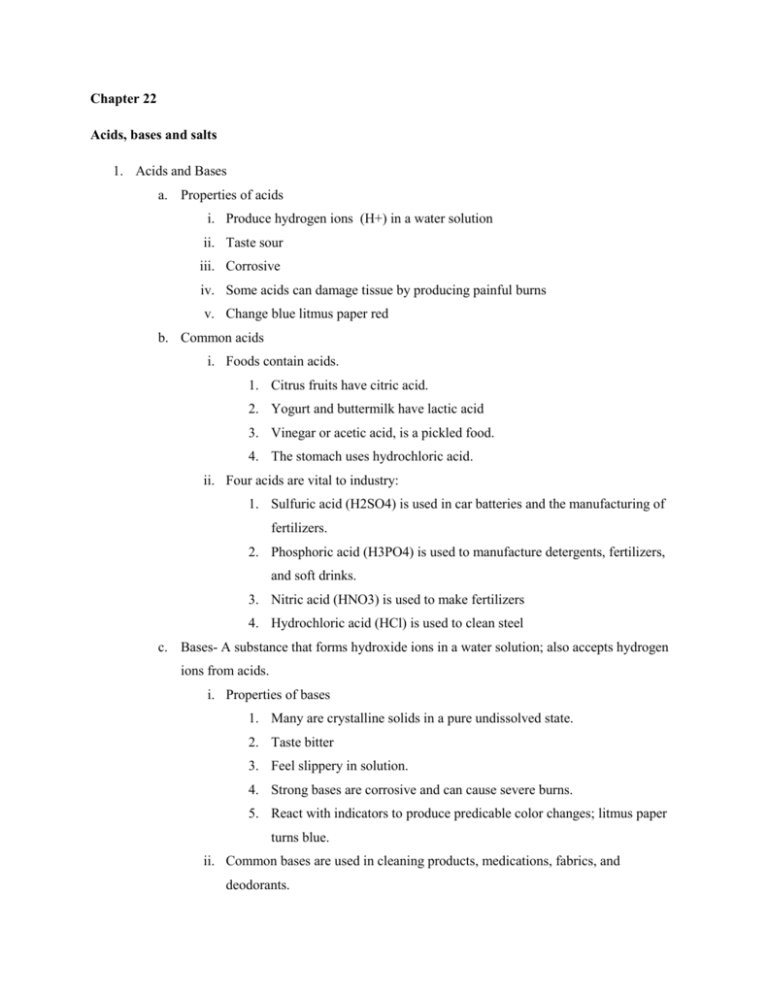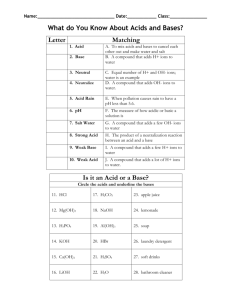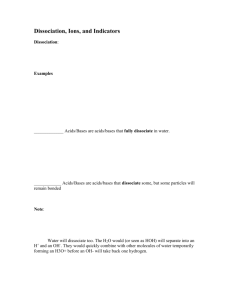Ch. 22 Notes
advertisement

Chapter 22 Acids, bases and salts 1. Acids and Bases a. Properties of acids i. Produce hydrogen ions (H+) in a water solution ii. Taste sour iii. Corrosive iv. Some acids can damage tissue by producing painful burns v. Change blue litmus paper red b. Common acids i. Foods contain acids. 1. Citrus fruits have citric acid. 2. Yogurt and buttermilk have lactic acid 3. Vinegar or acetic acid, is a pickled food. 4. The stomach uses hydrochloric acid. ii. Four acids are vital to industry: 1. Sulfuric acid (H2SO4) is used in car batteries and the manufacturing of fertilizers. 2. Phosphoric acid (H3PO4) is used to manufacture detergents, fertilizers, and soft drinks. 3. Nitric acid (HNO3) is used to make fertilizers 4. Hydrochloric acid (HCl) is used to clean steel c. Bases- A substance that forms hydroxide ions in a water solution; also accepts hydrogen ions from acids. i. Properties of bases 1. Many are crystalline solids in a pure undissolved state. 2. Taste bitter 3. Feel slippery in solution. 4. Strong bases are corrosive and can cause severe burns. 5. React with indicators to produce predicable color changes; litmus paper turns blue. ii. Common bases are used in cleaning products, medications, fabrics, and deodorants. d. Solutions of acids and bases i. Acid describes compounds that can be dissolved in water to form hydronium ions. ii. Base describes compounds that form hydroxide ions in a solution. iii. Solutions of acid and solutions of bases are conductors to some extent. 2. Strength of acids and bases a. The strength of an acid or base depends on how completely a compound separates into ions when dissolved in water. i. A strong acid ionizes almost completely into a solution. ii. A weak acid only partially ionizes in solution. iii. A strong base dissociates completely in solution. iv. A weak base does not dissociate completely in a solution. v. Strong acids and bases conduct more electricity than weak ones. vi. Equations for strong acids and bases use a single arrow, indicating ions are formed. vii. Equations for weak acids and bases use double arrows pointing in opposite directions indicating an incomplete reaction. viii. Strength and concentration are terms to describe the amount of acid or base dissolved. b. pH of a solution i. pH is a measure of the concentration of H+ in a solution or how acidic or basic it is. 1. pH lower than 7 means acidic 2. pH greater than 7 means basic 3. pH exactly 7 means a neutral solution. c. pH is determined using a universal indicator paper or a pH meter. d. Blood contains buffers which keep the pH in the blood balanced at about 7.4. 3. Salts a. Neutralization- chemical reaction between an acid and a base taking place in a water solution. b. Salt - Compound formed when the negative ions from an acid base combines with positive ins from a base; salts also form when acids react with metals. i. Salts are essential for many animals. ii. Other salt uses include manufacturing of paint, rubber, glass, soap, detergents, and dry blood cells. c. Titration is used to determine the concentration of an acidic or basic solution. i. A solution of a known concentration is the standard solution. ii. An acid/base indicator is added to the unknown solution. iii. A color change that persists is an end point. d. Soaps are organic salts with polar and nonpolar ends. i. The nonpolar, hydrocarbon end interacts with oil and dirt. ii. The polar end helps oil and dirt dissolve in water. e. Detergents- form more soluble salts with ions in hard water and reduce soap scum. Chapter 22 Vocabulary Acid - Substance that produces hydrogen ions, (H+), in a water solution Base - A substance that produces hydroxide ions, OH–, in a water solution Buffer - Solution that resists changes in pH when limited amounts of acid or base are added Hydronium ion - H3O+ ion, forms when an acid dissolves in water and H+ ions interact with water Hydroxide ion - OH– ion, forms when a base dissolves in water Indicator - Organic compound that changes color in acids and bases Neutralization - chemical reaction that occurs when the H3O+ ions from an acid react with the OH– ions from a base to produce water molecules and a salt PH - a measure of the concentration of hydronium ions in a solution using a scale ranging from 0 to 14, with 0 being the most acidic and 14 being the most basic Salt - Compound formed when negative ions from an acid combine with positive ions from a base Soap - Organic salt with a nonpolar, hydrocarbon end that interacts with oils and dirt and a polar end that causes it to dissolve in water Strong acid - Any acid that dissociates almost completely in solution Strong base - Any base that dissociates completely in solution Titration - Process in which a solution of known concentration is used to determine the concentration of another solution Weak acid - Any acid that only partly dissociates in solution Weak base - Any base that does not dissociate completely in solution









